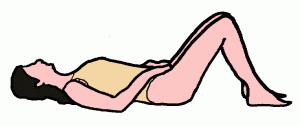Most people perform various abdominal crunching exercises to achieve their goal of toning stomach muscles. Abdominal Crunches strengthen the rectus abdominis muscle (6-pack muscle) and the obliques. The muscle that most people neglect when toning their stomach is the transversus abdominis, also known as the core muscle. The transversus abdominis provides spinal stability and tones the sides of the torso (“the love handles”). Click here to watch a video to see how to perform the basic contraction of the transversus abdominis. To learn more stabilization exercises to strengthen the transversus abdominis, contact Harbor Physical Therapy.
strengthening exercise
Clinical Question – Tendinitis
What is Tendinitis?
Tendinitis is an inflammation of a tendon. This is most often caused by overuse. Common areas that develop tendinitis are at the elbow, back of the ankle, knee, and shoulder. Symptoms of tendinitis are tenderness to touch over the tendon, pain with movement, decrease range of motion, decrease strength, and swelling of the tendon. Physical Therapy is beneficial for patients with tendinitis because it decreases symptoms and strengthens/stretches the injured area to prevent re-injury.
Clinical Question – Sitting Posture
Will strengthening my stomach muscles help me with my sitting posture at work?
Yes, by strengthening your core muscles it will allow you to maintain an ideal sitting posture for a longer duration. Having weak core muscles will cause you to sit with a more forward flexed posture and you will not be able to sustain good posture throughout your workday.
Exercise Guidelines
There are many different opinions on the frequency and duration a person should exercise in a given week. Therefore, in 2007, The American College of Sports Medicine (ACSM) revised their guidelines for exercise to achieve a healthy lifestyle. These guidelines are good principles to think about when planning an exercise regimen. They are as follows:
- Do fairly intense cardio 30 minutes a day, five days a week or do energetically intense cardio 20 minutes a day, 3 days a week.
- Do eight to 10 strength-training exercises with 8 to 12 repetitions of each exercise twice a week.
Tips for following the guidelines:
Life gets busy so sometimes it is difficult to fit exercise into our schedules. Here are some tips to help include exercise into your life.
Mix it up:
- To meet the guidelines, you can vary the cardiovascular exercise you perform. Such as, you can walk vigorously for 30 minutes twice a week, ride a bike at a moderate intensity for 20-30 minutes twice a week, and jog/run at a higher intensity one-two days a week.
Do it several tmes a day in shorter time frames:
- If you are too busy to do 30 minutes of consecutive exercise, you can perform intense 10-minute bouts of exercise 3 times a day, equaling 30 minutes.
Work out with friends/family:
- To motivate you to continue your exercise routine, it is helpful to bring friends and family in on the fun! Therefore, you can motivate each other to continue exercising. It is also helpful to get involved in exercise classes. You will find that it is very motivating to have an instructor pushing you to make it through your workout class.
Set your schedule:
- Just like you schedule a meeting with work or friends, schedule exercise! By scheduling exercise, it helps you keep up with your routine and stay healthy.
Starting an exercise program:
- Some people find starting an exercise program very intimidating. If you fall in this category, there are some options out there for you. Harbor Physical Therapy offers wellness evaluation. This entails a session with Dr. Amanda working on whatever aspect of your body you feel needs expert attention. Dr. Amanda can provide you with a workout regimen that gets you started on your healthy lifestyle. Also, if you get bored with your routine or want to try something different, Dr. Amanda can continue providing you guidance. Please give us a call at 443-524-0442 for details.
Can back pain be prevented?
There are several measures you can take throughout your day to reduce the likelihood of lower back pain.
1. Maintain correct posture in sitting and standing positions.
- Be sure to sit in a chair with lumbar support (lower back support).
- Always have your computer monitor at eye level and keyboard in front of your body.
2. Lift heavy objects with proper body mechanics.
- Avoid bending down with twisting motions.
- Always bend through your knees and slightly hinge at the waist.
3. Avoid repetitive lifting of weights and take breaks as needed.
- Overtime, repetitive lifting of weights will cause a stress injury to the spine. This could lead to a disc bulge (herniated disc) and spinal degeneration.
4. Perform core strengthening exercises regularly.
- Avoid excessive sit-ups because it puts heavy strain on the lumbar spine.
- Avoid back extension exercises.
Example of a Basic Core Strengthening Exercise
- Lay on your back with your spine flat on the surface.
- Squeeze your stomach muscles down toward the surface to flatten your back (Note: Try not to hold your breath during this part).
- Hold for 5-10 seconds and repeat.
- To help achieve the correct contraction, pretend you are putting on a tight pair of jeans and squeezing your stomach muscles to fasten the zipper.
- This exercise is strengthening the Transversus Abdominus muscle.

